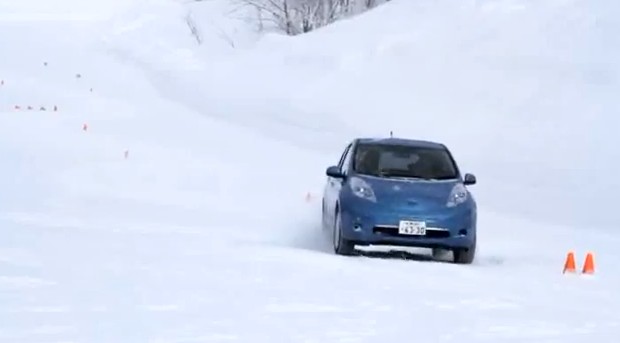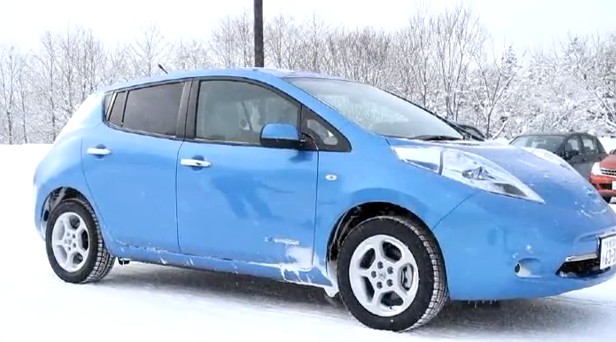2012 Nissan Leaf winter test
So how on earth do you use an electric car in places that consistently get many feet of snow every winter?
Short answer: snow tires.
Long answer: plan ahead.
Being based in Vancouver--what passes for the Canadian tropics*, where snow had to be helicoptered onto local ski hills during the 2010 Olympics--your correspondent had no idea how well electric cars actually stack up, until he started making inquiries.
MORE: Electric Cars In The Winter: Ultimate Guide
But with winter approaching, a recent discussion on the Canada Nissan Leaf Owners Facebook group seemed apropos, all about driving plug-in electric vehicles in the northern winter.
The overarching advice we got was to purchase snow tires, because low-rolling-resistance tires and ice don't mix. Well-stocked winter survival kits were next.
Third place went to pre-heating the cabin while the car was still plugged in, so the battery could maintain its maximum propulsion range and grid electricity could be used for the heat.
Nissan Leaf electric car range as a function of temperature [data: Ricardo Borba]![Nissan Leaf electric car range as a function of temperature [data: Ricardo Borba] Nissan Leaf electric car range as a function of temperature [data: Ricardo Borba]](https://images.hgmsites.net/lrg/nissan-leaf_100442928_l.jpg)
Many business establishments in the Canadian "frozone" offer 110-volt plugs for engine-block heaters, so pre-heating can often be done both in the home garage and at work.
When it's really cold, EVs droop...
Our northernmost correspondent was Robin Sipe of Fort St. John, B.C., latitude 56 degrees north.
While not as far north as Oslo, the landlocked town is colder than the coastal Norwegian capital, which is warmed by the Gulf Stream ocean current. Oslo's January lows average -7 degrees Celsius (19 degrees Fahrenheit) while Fort St. John sees an average low of -19 Celsius (-2 Fahrenheit).
Robin reported that Arctic weather caused a big droop in his Ford Focus Electric's range, from 150 km to as little as 60 km.
He did add the caveat, though, that the 60-percent range loss was the worst-case scenario of him starting his electric car after an extended soak, unplugged, in -36C weather--with all the heaters on, full-blast.
2012 Nissan Leaf winter test
...but regular cars don't start at all
More interestingly, he commented that when combustion vehicles are left to cold soak at these temperatures, they "brick". That is to say, they don't start. As such, they suffer 100-percent range loss.
This is often due to the lead-acid battery getting too cold. Electric vehicles get around this problem by running small heaters off the traction battery when there's a risk of the electrolyte freezing.
The Nissan Leaf incorporates a 300-Watt heater for this purpose.
MORE: Nissan Leaf Range: How Much Does It Lose In The Cold?
To be fair, it's easy to avoid ICE bricking, and most drivers plug their vehicles into block heaters while doing errands. But a minority – Robin ventured 20 percent -- simply leave their vehicles running.
This shocked your correspondent, because no one in Vancouver would ever do this--a local suburb was the one-time car theft capital of North America!
Is block-heater aversion a behavioral vestige from when gas was cheap? Are they too inconvenient to connect through thick mittens / gloves? Or maybe block heaters leave interior cabins stone cold?
2012 Nissan Leaf winter test
There must be reasons why electric vehicle early-adopters plug in religiously, while northerners can't be troubled to block-heat their cars.
MORE: 2012 Nissan Leaf Proves Itself On Snowy Japanese Test Course (VIDEO)
There's a graduate thesis in there, I'll bet – and a lot of money, too, for the entrepreneur who invents a better-connecting, smartphone-controllable block heater system.
Cabin heat gets half the blame
Robin's observations left open the question of whether range droop occurred due to the cold weather, or his (understandably) having the heater on at full blast.
Nissan Leaf electric car range as a function of temperature [data: Ricardo Borba]![Nissan Leaf electric car range as a function of temperature [data: Ricardo Borba] Nissan Leaf electric car range as a function of temperature [data: Ricardo Borba]](https://images.hgmsites.net/lrg/nissan-leaf_100442927_l.jpg)
Nissan Leaf owner Ricardo Borba had the answer.
The Ottawa resident tracked his Leaf's estimated range over 500+ trips, grouped the numbers by outdoor temperature, and plotted them.
Working a hunch, he made cold-weather trips with and without any cabin heating, resulting in the attached chart – available in metric (at left) and Imperial units (previous page).
Ricardo's data showed that his Leaf's range dropped by about 20 miles, or 30 km, between summer and winter. Heating the cabin reduced the range by a further 20 miles.
Which means only half the drop was battery-related; the rest came from the parasitic load to warm the cabin.
2012 Nissan Leaf winter test
Ricardo mitigated the problem by buying a small ceramic heater to heat only the driver area -- on-vehicle heating systems are necessarily designed to warm the entire cabin equally, so are less efficient.
He did note that Nissan has since improved the efficiency of its cabin heating system, and we can imagine other automakers will be innovating in this area, to reduce the draw on the batteries.
If you'd like to thank Borba for his painstaking efforts on behalf of the electric vehicle community, his blog is well worth a visit.
* Vancouver could one day lose its claim to being the Canadian tropics, given the country's century-long (pipe) dream of annexing the British-administered Turks and Caicos Islands (near Bermuda) into Canadian Confederation. Indeed, the Caribbean territory even made proposals to that effect in the 1970s. Nine years ago, one province offered to integrate the islands into their territory to simplify any constitutional paperwork (!) -- and one must admit, "Nova Scotia, Turks and Caicos" does have a certain ring to it.
[EDITOR'S NOTE: An earlier version of this article incorrectly implied that the Leaf could be parked for a month in Antarctica, due to an embarrassing math error on the contributor's part. In fact, the Leaf could only be parked for a weekend, as 24 kWh = 300 W x 80 hours, not 800 hours. This puts the figures in line with Nissan's warranty terms, as noted by sharp-eyed readers in the comments. Many thanks to Gordon Wong for the catch.]
_______________________________________________












